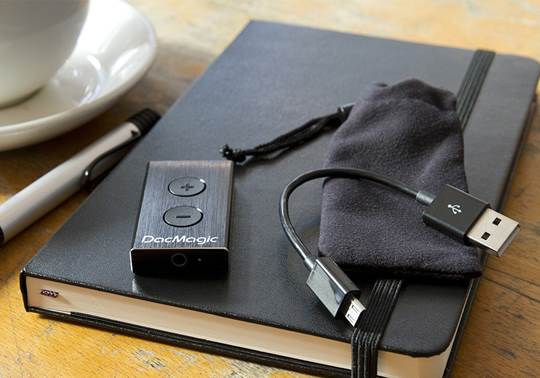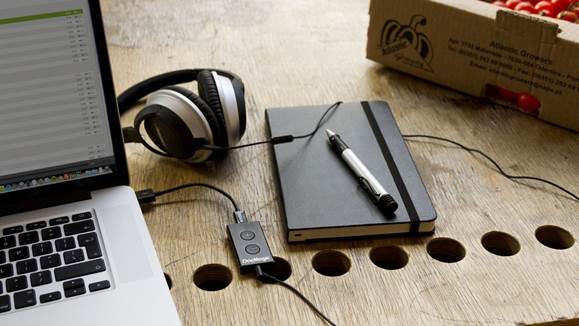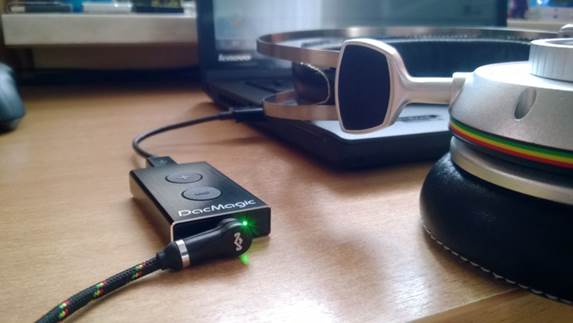Increasingly, many of us are enjoying hi-res music stored on
a computer having been downloaded from an HD audio website such as Linn
Downloads or the Nordic Sound.
To the concert connoisseur using an internal DAC is like asking
the LSO to play in the bandstand at Regents Park in a force 10 gale. There is
already a handful of external USB DACs on the market including the acclaimed
(HFC377) Meridian Explorer, which retails for $411, and the equally impressive $353
AudioQuest Dragonfly.

Audio DacMagic
Size matters
Cambridge Audio ships the DacMagic XS in a much larger box
than is needed for its size. The contents have not settled during
transportation like a box of cornflakes, but the packaging makes you feel
better about spending $164. Cunning, eh? But it’s pleasing to discover that the
unit is in fact smaller even than the picture on the front. The 5.4cm-long
device weighs less than 25g, but seems durable and looks classy with slightly
rounded edges and a tough, brushed aluminum finish. Two large buttons are
provided for altering the volume in 54 steps. You can also use the slider in
iTunes, but the quickest and most convenient method of volume adjustment – the
function buttons on a keyboard – are annoyingly disabled.
DacMagic XS is supplied with a 14cm-long USB cable and a
soft pouch for protection during storage. Adopting a cable-tethering approach,
like the Meridian Explorer, means it won’t stick out at the side of your laptop
like the Dragonfly does and is less likely to break than a built-in USB
connector. One end of the unit sports a micro USB socket the other hosts a
gold-plated 3.5mm jack and a tiny LED, which glows when in use.

Cambridge Audio
DacMagic XS DAC
Mainly intended for use as a headphone DAC, you could also
hook up the DacMagic XS to a desktop amplifier using the 3.5mm output. Inside
is a high-quality ESS9023 24-bit DAC that supports sample rates up to 192kHz.
Minimum headphone impedance is 12ohms and the output voltage is a generous 2V
RMS, meaning you shouldn’t ever feel short changed volume-wise when using long
cable runs or low sensitivity headphones. You can manually switch from USB 1.0,
which has a maximum sample rate of 96kHz, to 192kHz-compatible USB 2.0
operation by simultaneously pressing the volume buttons for a few seconds,
whereupon the LED changes from green to blue. On a Mac you can easily check the
sample rate from within the Audio MIDI utility and manually match the sample
rate to the native rate.
I use a set of Philips Fidelio M1 headphones, which are
closely matched impedance-wise to the DacMagic XS, and the results are good,
but not startling with MP3s. Thomas Newman’s Six Feet Under, for example, has
decent resolution throughout the dynamic range and reasonable bass, but the
clarinet lacks a bit of spit and polish and transients tail off quickly. It’s a
similar story with Kyu Sakamoto’s Sukiyaki, where the bass feels a bit cramped.
Stepping up to some AAC tub-thumping electronica, Silent Shout by The Knife is
delivered with greater bass response extracting maximum impact from the muffled
drums. With Sad February by the Unthanks, a 16/44.1 AAC file, bass again lacks
a bit of firmness, but the midrange and upper registers are nice and open,
revealing all the emotion of the vocals and chilliness of the piano.
Moving on up
Upping the ante with some 24/96 ALAC fodder in the shape of
Susan Wong’s Desperado it’s like removing a pair of wellies and slipping into
your favorite slippers. Now my ears are as happy as an eight year old in
Hamleys. The additional dynamic range gives everything so much more punch and
control, but there’s a lightness of touch so that the mesmerizing vocals seem
to float.

Cambridge Audio
DacMagic XS
Mozart’s Violin Concerto No 4 in D Major– down-sampled to
192kHz from a DXD 24/352.8kHz WAV file – reveals incredible clarity, especially
the lead violin, which is crisper than an early morning February stroll.
The wonderfully compact DacMagic XS doesn’t have quite the
same amount of authority as the Meridian Explorer (nor does it have an S/PDIF
optical output for that matter), but it is less than half the price. Given how
masterfully it handles hi-res sources in particular and its sterling work with
lower-quality material, it isn’t hard to say that this is probably the best entry-level
DAC around.
|
Specifications
·
Price: $164
·
Connections: Micro USB input, 3.5mm analogue output
·
Digital to Analogue Converter: ESS9023 24-bit DAC
·
Sample Rates Supported: USB 1.0 mode: 16/24-bit, 44.1kHz,
48kHz, 88.2kHz, 96kHz; USB 2.0 mode: 16/24-bit, 44.1kHz, 48kHz, 88.2kHz,
96kHz, 176.4kHz, 192kHz
·
Output Voltage: 2V RMS
·
Max. Power Consumption: 150mW
·
Min. Headphone Impedance: 12 Ohms
·
Frequency Response: +/-0.2dB 20Hz – 20kHz
·
THD (unweighted): <0.004%
·
SNR: 103 dBr (unweighted)
·
Crosstalk: 66dB
·
Output Impedance: 0.5 Ohms
·
Volume Steps: 53 steps (54 different volume levels)
·
Dimensions (W x H x D): 30 x 10 x 53.5mm (1.2 x 0.4 x 2.1’’)
·
Weight: 100g (3.5oz)
|